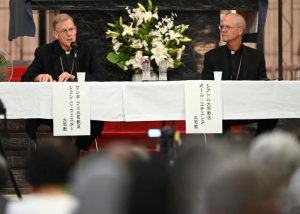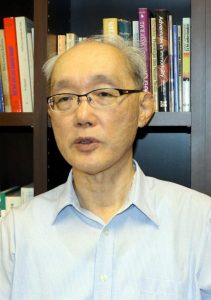Catholic circles in Japan and the U.S. cooperate to eliminate nuclear weapons; Archbishop of Santa Fe, the “development base of atomic bombs,” speaks today in Hiroshima
Aug. 5, 2024
by Yu Yamada, Staff Writer
On August 5, the Most Reverend John Wester, 73, of the Archdiocese of Santa Fe in the United States, where the atomic bombs dropped on Hiroshima and Nagasaki were developed, will speak at the Memorial Cathedral for World Peace in Hiroshima’s Naka Ward. His visit, which follows last year's, is timed to coincide with the anniversary of the atomic bombing of Hiroshima on August 6. In his speech, he will call for broad cooperation to realize a world without nuclear weapons.
Archbishop Wester, who says nuclear weapons are the ultimate evil that may annihilate all humanity, issued a pastoral letter in January 2022 expressing his determination to abolish nuclear weapons. In August 2023, he visited Hiroshima and Nagasaki with the Archbishop of Seattle, where many nuclear warheads are deployed, and attended the ceremonies on the day of the bombings.
In his address on August 5, he will call on all dioceses around the world to join the Partnership for a World Without Nuclear Weapons (PWNW), which was formed in 2023 with the Dioceses of Hiroshima and Nagasaki and the Archdiocese of Seattle during his last visit to Japan.
Bishop Mitsuru Shirahama, Diocese of Hiroshima, said, “There are some other dioceses that are already positively considering joining. We want to expand the partnership, and appeal to people about the folly of nuclear weapons.
Despite the long and difficult road ahead, we should continue to raise our voices
The theory of nuclear deterrence still has great influence in international society, but the movement to stop and change the trend is beginning to grow in the Catholic community. In addition to the visit to Japan by the head of the archdiocese where the nuclear weapons development center is located, a group of American Christians made a pilgrimage to Hiroshima in March of this year to apologize to the atomic bomb survivors for their country’s atomic bombing. What is the background of this movement? We asked Ichiro Mitsunobu, 68, a professor in the theology department at Sophia University, who has long been committed to peace movement as a priest.
The anti-nuclear weapons movement among U.S. Catholics continues.
For a long time, Catholic churches focused on missionary work to support a religious life, lacking active involvement in society. The turning point was the Second Vatican Council, beginning in 1962, which called for a shift toward the pursuit of peace as a church open to society.
The Vatican City State promptly ratified the Treaty on the Prohibition of Nuclear Weapons (TPNW) when it was adopted by the United Nations in 2017. Pope Francis’ definitive statement made in Hiroshima in 2019, “The possessing of nuclear weapons is itself immoral,” is still fresh in our minds. I believe that the actions of the Archdiocese of Santa Fe and others are a response to this trend.
In the first place, existence of nuclear weapons is clearly against the teachings of Christianity. I believe Christians in the United States have understood that “nuclear weapons are not good as the Pope says.”
However, the majority of Americans still believe that “the atomic bombings saved the lives of a million people.” Many clergypersons find it difficult to mention the blame for the atomic bombings and speak ambiguously about it.
In these circumstances, the Archbishops of Santa Fe and Seattle are speaking out clearly and taking concrete action to abolish nuclear weapons. There will be many difficulties on the road ahead, as they were just two priests among many in the United States. But I would like to praise them for their courage.
What do you think is needed to expand the circle?
Christianity’s idea of peace is a world where people associate, work, and interact with each other. A cross shows God’s love to remove hostility and conflict between people, and works to reconcile two divided things.
On the other hand, the theory of nuclear deterrence is like a rigid situation of holding knives to each other’s necks. There is no way it can bring about fundamental peace.
I myself spent two years in my twenties at the Nagatsuka Jesuit novitiate (Hiroshima’s Asaminami Ward), looking from my room in the direction of the hypocenter. In the cemetery near the novitiate, there were many tombstones with the date of death inscribed as August 1945, including those of many small children. I always felt like they were telling me something. That was the starting point of my activities to realize peace.
Calling for the abolition of nuclear weapons is often perceived as an idealistic theory, and I am keenly aware of the difficulty of spreading the idea in real political scenes.
What we must not forget is that religion is not something that everyone should follow in a totalitarian way, but each person takes the teachings as their own and brings them back into their lives. I understand it will be a long and difficult road ahead, but we must continue to raise our voices without giving up.
(Originally published on August 5, 2024)
On August 5, the Most Reverend John Wester, 73, of the Archdiocese of Santa Fe in the United States, where the atomic bombs dropped on Hiroshima and Nagasaki were developed, will speak at the Memorial Cathedral for World Peace in Hiroshima’s Naka Ward. His visit, which follows last year's, is timed to coincide with the anniversary of the atomic bombing of Hiroshima on August 6. In his speech, he will call for broad cooperation to realize a world without nuclear weapons.
Archbishop Wester, who says nuclear weapons are the ultimate evil that may annihilate all humanity, issued a pastoral letter in January 2022 expressing his determination to abolish nuclear weapons. In August 2023, he visited Hiroshima and Nagasaki with the Archbishop of Seattle, where many nuclear warheads are deployed, and attended the ceremonies on the day of the bombings.
In his address on August 5, he will call on all dioceses around the world to join the Partnership for a World Without Nuclear Weapons (PWNW), which was formed in 2023 with the Dioceses of Hiroshima and Nagasaki and the Archdiocese of Seattle during his last visit to Japan.
Bishop Mitsuru Shirahama, Diocese of Hiroshima, said, “There are some other dioceses that are already positively considering joining. We want to expand the partnership, and appeal to people about the folly of nuclear weapons.
Interview with Ichiro Mitsunobu, Professor in the Department of Theology at Sophia University
Despite the long and difficult road ahead, we should continue to raise our voices
The theory of nuclear deterrence still has great influence in international society, but the movement to stop and change the trend is beginning to grow in the Catholic community. In addition to the visit to Japan by the head of the archdiocese where the nuclear weapons development center is located, a group of American Christians made a pilgrimage to Hiroshima in March of this year to apologize to the atomic bomb survivors for their country’s atomic bombing. What is the background of this movement? We asked Ichiro Mitsunobu, 68, a professor in the theology department at Sophia University, who has long been committed to peace movement as a priest.
The anti-nuclear weapons movement among U.S. Catholics continues.
For a long time, Catholic churches focused on missionary work to support a religious life, lacking active involvement in society. The turning point was the Second Vatican Council, beginning in 1962, which called for a shift toward the pursuit of peace as a church open to society.
The Vatican City State promptly ratified the Treaty on the Prohibition of Nuclear Weapons (TPNW) when it was adopted by the United Nations in 2017. Pope Francis’ definitive statement made in Hiroshima in 2019, “The possessing of nuclear weapons is itself immoral,” is still fresh in our minds. I believe that the actions of the Archdiocese of Santa Fe and others are a response to this trend.
In the first place, existence of nuclear weapons is clearly against the teachings of Christianity. I believe Christians in the United States have understood that “nuclear weapons are not good as the Pope says.”
However, the majority of Americans still believe that “the atomic bombings saved the lives of a million people.” Many clergypersons find it difficult to mention the blame for the atomic bombings and speak ambiguously about it.
In these circumstances, the Archbishops of Santa Fe and Seattle are speaking out clearly and taking concrete action to abolish nuclear weapons. There will be many difficulties on the road ahead, as they were just two priests among many in the United States. But I would like to praise them for their courage.
What do you think is needed to expand the circle?
Christianity’s idea of peace is a world where people associate, work, and interact with each other. A cross shows God’s love to remove hostility and conflict between people, and works to reconcile two divided things.
On the other hand, the theory of nuclear deterrence is like a rigid situation of holding knives to each other’s necks. There is no way it can bring about fundamental peace.
I myself spent two years in my twenties at the Nagatsuka Jesuit novitiate (Hiroshima’s Asaminami Ward), looking from my room in the direction of the hypocenter. In the cemetery near the novitiate, there were many tombstones with the date of death inscribed as August 1945, including those of many small children. I always felt like they were telling me something. That was the starting point of my activities to realize peace.
Calling for the abolition of nuclear weapons is often perceived as an idealistic theory, and I am keenly aware of the difficulty of spreading the idea in real political scenes.
What we must not forget is that religion is not something that everyone should follow in a totalitarian way, but each person takes the teachings as their own and brings them back into their lives. I understand it will be a long and difficult road ahead, but we must continue to raise our voices without giving up.
(Originally published on August 5, 2024)









